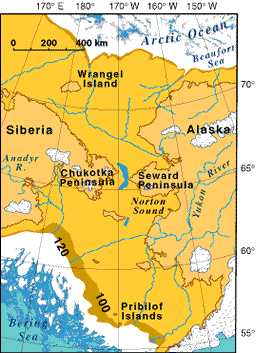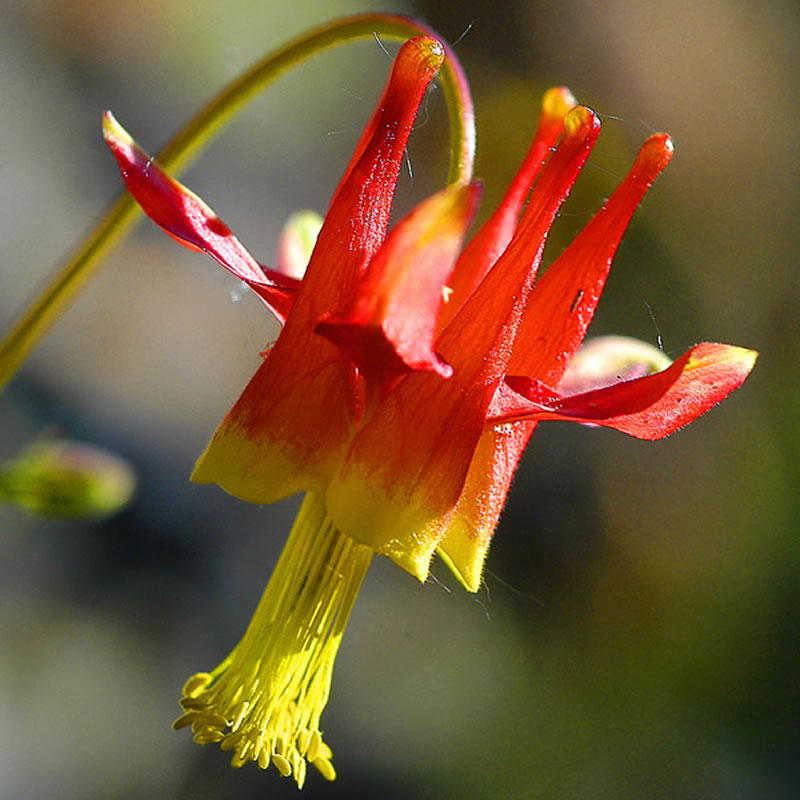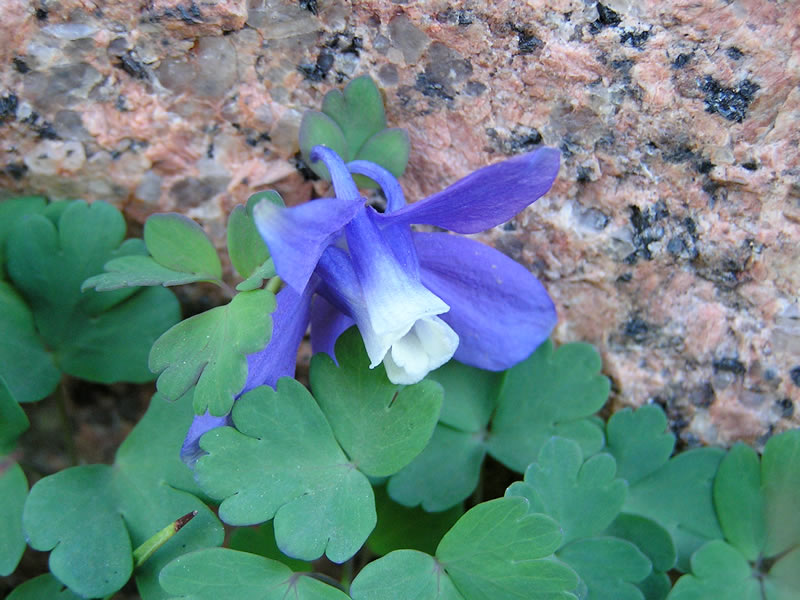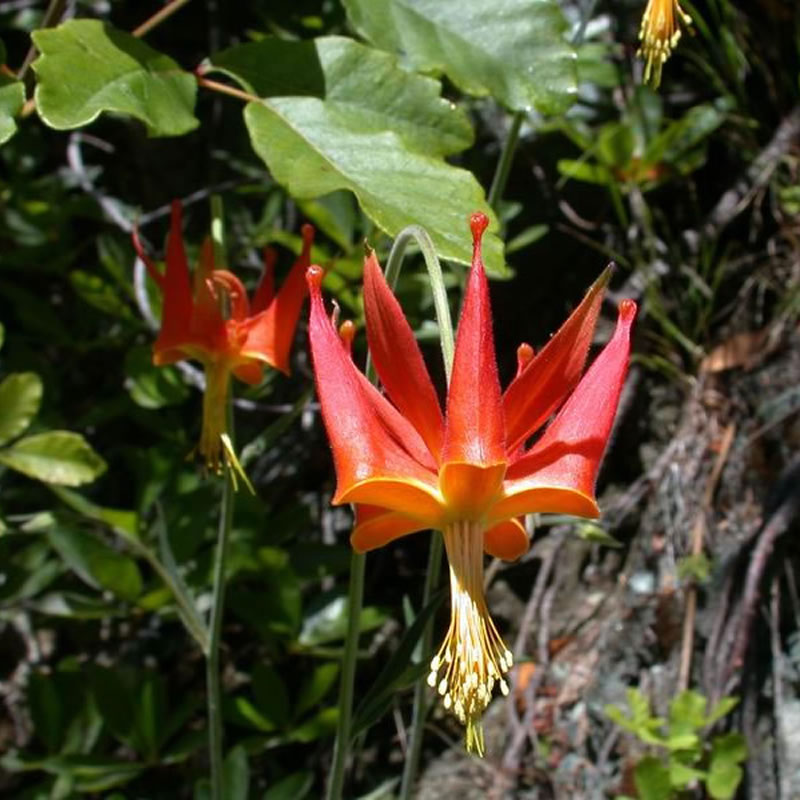Aquilegia Express: Columbine Natural History
Beringia
 Map of the Bering land bridge during the late Wisconsin glaciation, when global sea level dropped to about 120 meters or more below its present position. Courtesy USGS.
Map of the Bering land bridge during the late Wisconsin glaciation, when global sea level dropped to about 120 meters or more below its present position. Courtesy USGS.
Arrival of the genus Aquilegia into North America is a recent event occurring 10,000 to 40,000 years ago during the Pleistocene. At this time, the Bering land bridge exposed huge areas of the shallow continental shelf. This provided a broad land connection between northeastern Asia and unglaciated parts of Alaska and the Yukon. This land bridge allowed many plants and animals to spread between the Asian and American continents. It is believed that columbines crossed into North America from Asia over the Bering land bridge during that period. A progenitor columbine began to radiate rapidly out of Alaska and throughout the North American continent. As the columbines were moving through out the continent, new species developed.
Recent scientific evidence has determined that the genus Aquilegia originated in Eastern Europe and Central Asia. DNA analyses have determined two European species and one Asian species form the ancestral group from which all other species of Aquilegia evolved. One species of columbine expanded its range across the Bering land bridge connecting Asia and North America during the glacial period 10,000 to 40,000 years ago. The DNA analyses demonstrate that the Asian species Aquilegia viridiflora separates out with the North American species and thus may share an ancestral species with the North American columbines.
Once the land bridge ceased to exist, this Old World “founder” species may have evolved over time into the present-day columbine we call Aquilegia brevistyla (small flower columbine). Other research and the morphological characteristics of Aquilegia brevistyla and its current geographic distribution from Alaska to Ontario, Canada support this interpretation.
South, from Alaska
Blue Columbines
As the genus Aquilegia radiated down through the Rocky Mountains, it evolved different colors and shapes in response to newly available pollinators, hawk moths, and hummingbirds. Bees and bumblebees pollinate the deep blue flowered columbines, Aquilegia brevistyla, Aquilegia jonesii, Aquilegia saximontana, and Aquilegia scopulorum, like their similarly colored Eurasian counterparts. The North American deep blue flowered columbines all occur in alpine and subalpine habitats or in northern latitudes where other columbine pollinators, hawk moths, and hummingbirds do not commonly occur.
 Aquilegia coerulea. Photo by Al Schneider.
Aquilegia coerulea. Photo by Al Schneider.
Aquilegia coerulea (Colorado blue columbine) ranges in color from dark blue to pale blue to white. Aquilegia coerulea is the southern most (northern New Mexico) occurring dark blue flowered columbine and it occurs at high elevations where colder temperatures generally preclude hawk moths. As Aquilegia coerulea expanded out of the Rocky Mountains into lower elevations and warmer temperatures, the species developed into white or very pale blue varieties. This change to a lighter coloration co-evolved, as hawk moths were available as an alternative pollinator to bees and bumblebees. It is also interesting to note that the spurs on the dark blue Aquilegia coerulea are short, similar to the other dark blue, high elevation columbines whereas the spurs on the pale blue to white Aquilegia coerulea are longer. This spur extension is believed to be a co-evolved adaptation to pollination by hawk moths with their long tongues.
Yellow Columbines
Others species came into being with different shades of yellow, cream, and pink (A. barnebyi, A. chaplinei, A. chrysantha, A. flavescens, A. micrantha and A. pubescens). These columbines evolved in relationship to different species of hawk moths available as pollinators. Part of these species adaptations were the increase in the amount of nectar and increasing length of the spurs. Additional nectar selected for increased number of visits by hawk moths and higher likelihood for successful pollination. Longer spur lengths were selected for by pollinating hawk moths with longer tongues. Foraging by long-tongued hawk moths on shorter spurred columbines resulted in less nectar being available to their short-tongued hawkmoth pollinators. Due to decreased nectar availability, the short-tongued hawk moths avoided those columbines in favor of other species of flowers with available nectar. As a result, in those habitats the shorter spurred columbines disappeared because they were not being successfully pollinated, thus ensuring future generations.
 Aquilegia micrantha. Photo by Al Schneider.
Aquilegia micrantha. Photo by Al Schneider.
Red Columbines
Another concurrent development in the adaptation of Aquilegia to southwest North American ecosystems was the development of red flowered columbines and increased sugar content in the nectar (A. triternata, A. schockleyi, A. grahamii, A. eximia, A. elegantula, A. desertorum, A. formosa, and A. canadensis) of flowers pollinated by hummingbirds. Increased sugar content in the nectar evolved to satisfy the higher energy needs of hummingbirds compared to other columbine pollinators such as hawk moths, bees, and bumblebees.
 Aquilegia elegantula. Photo by Al Schneider.
Aquilegia elegantula. Photo by Al Schneider.
 Aquilegia formosa. Photo by John O’Neill.
Aquilegia formosa. Photo by John O’Neill.
The differing floral shapes of red flowered columbines, especially the spurs, have resulted from their adaptation and selection to different species of hummingbirds as pollinators. Aquilegia canadensis is the only columbine east of the 100th meridian and found throughout the entire range of the ruby-throated hummingbird.
Pollen-gathering bumblebees also pollinate red flowered columbines. This is important because in some instances, Aquilegia canadensis and Aquilegia formosa have both moved further north than the range of their pollinating hummingbirds. This has occurred because of the availability of bees and bumblebees to pollinate their flowers. Aquilegia formosa has extended its range north through coastal British Columbia and Alaska. Plant biogeographers speculate that if the Bering land bridge surfaces once again, a red flowered columbine may become established in the Old World; and thus, the journey of the columbines would come full circle.









